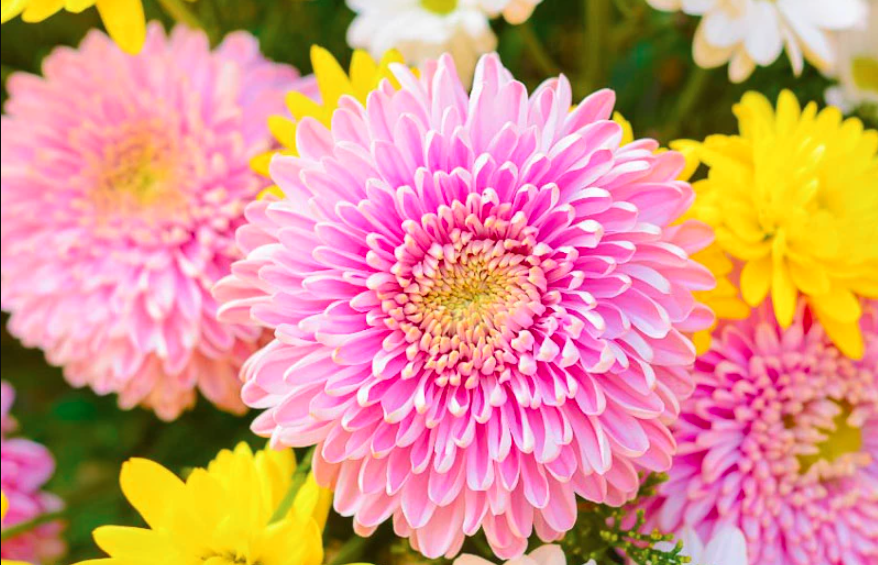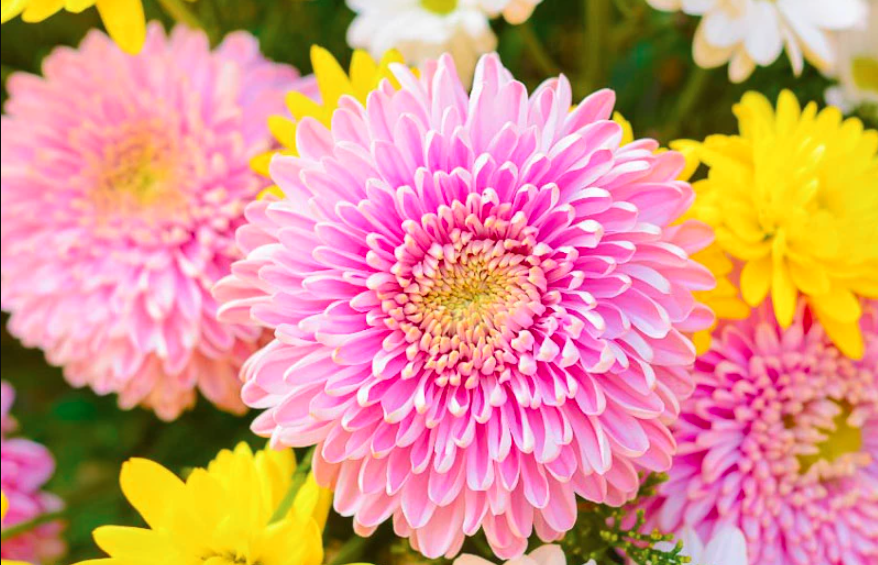
hrysanthemum flowers or “mums” are a rich genus exhibiting a huge variety of colors, sizes, and shapes. Originating in China and Japan, they have made their way into gardens across the globe. Don’t have any in your garden yet? That’s okay. This is your one-stop guide on how to plant Chrysanthemums and how to care for them. Get started now!
What types of Chrysanthemums can you grow in your garden? What do they symbolize in the language of flowers? And what are their health benefits? Find all you need to know about them in our easy guide.
Meaning of Chrysanthemum Flowers
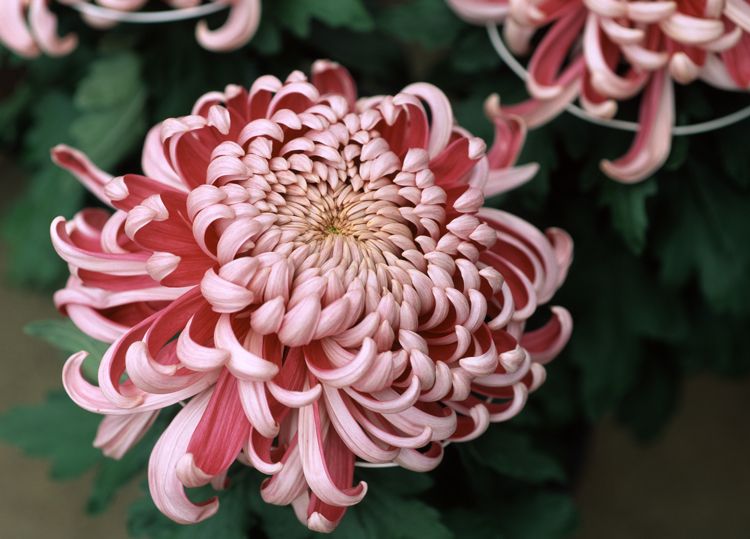
Chrysanthemums originated in China where they were mainly used for natural remedies and incorporated into dishes. The name of the plant is derived from the Greek words “chrysos” meaning gold and “anthemon” signifying flower.
There are many different meanings associated with these flowers, mainly related to their colors, cultural origins, and time periods.
Chrysanthemums Color Significance
This cheerful flower symbolizes optimism, fidelity, joy, love, and longevity. However, specific colors have certain meanings of their own.
- Yellow Chrysanthemums symbolize sorrow or neglect.
- Red Chrysanthemums convey passionate and deep love.
- Purple or Violet Chrysanthemums symbolize wishing someone good health, fast recovery, and support.
- White Chrysanthemums stand for honesty, loyalty, and devotion.
Chrysanthemum Cultural Meanings
![Gifting Chrysanthemums: Meanings & Cultural Significance [2025]](https://www.trustedgiftreviews.com/wp-content/uploads/2023/10/A-Guide-to-Chrysanthemums-Meaning-Symbolism-and-Uses.jpg)
The significance of these flowers varies across countries, cultures, and time periods.
- In Australia, a Chrysanthemum is a traditional gift for mothers day, which is in fact related to their abbreviation “mums”.
- During Victorian times, Chrysanthemums were gifted to symbolize friendship, support, and well-being.
- In Austria, Belgium, and other European countries, Chrysanthemums are used as a remembrance flower for loved ones, for funerals, and in honor of the dead. The Incurve Chrysanthemums, in particular, symbolize death.
- In the USA, these flowers stand for joy, positivity, cheerfulness, and affection.
- In Asian countries in general, Chrysanthemum flowers signify rebirth and life.
- Japan has an annual festival to celebrate these beautiful flowers called the “Festival of Happiness“.
As the Chrysanthemum blooms during the fall, it’s also known as the flower of fall or of November and October. In this sense, it signifies joy and beauty at the beginning of the harsh cold months of winter.
Types of Chrysanthemum Flowers
As Chrysanthemums flowers are some of the most popular flowers in the world with over 1800 species, there are many types to choose from.
Here is a list of the top types of Chrysanthemum flowers to brighten up your garden.
1. Spider Bloom Chrysanthemum (Chrysanthemum morifolium)
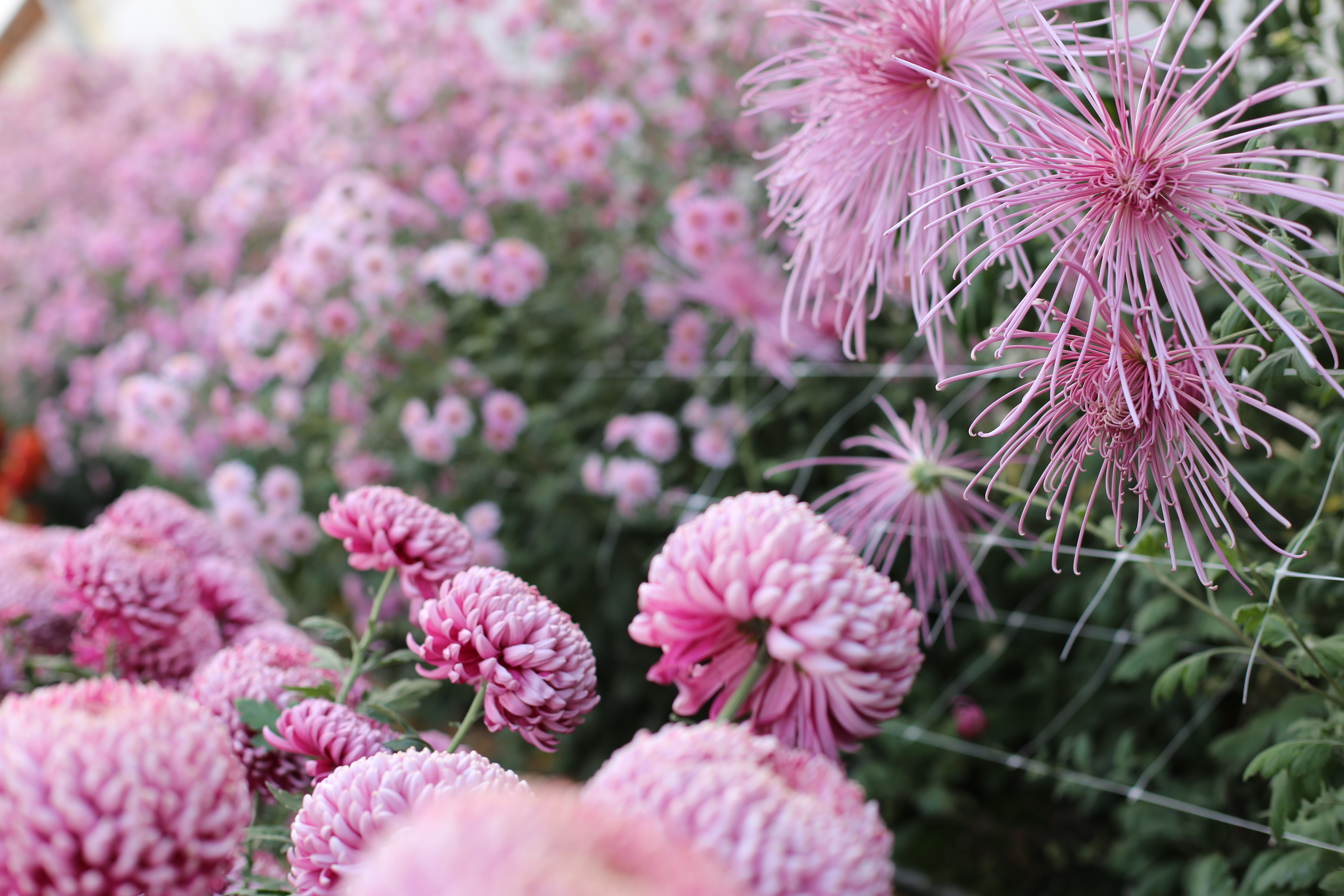
The Spider Bloom has long thin petals that resemble spider legs. Growing up to 6 inches long, the petals develop in random directions and may even curl at the tips.
This interesting flower has a fresh scent and comes in an array of colors including warm oranges, yellows, pinks, purples, bronze, and white. Common varieties include Western Voodoo and Evening Glow.
Tip: Spider blooms are great for ornamental and decorative uses.
2. Pompon Chrysanthemum (Chrysanthemum indicum)

This “mum” resemble a pom-pom, doesn’t it? The Pompon Chrysanthemum has short and curved petals that fully cover the disc of the flower.
Pompon Mums are fairly small in comparison to other varieties. However, this does not take away from their sweet looks.
They grow between 2-3 feet in height and come in a variety of colors, such as purples, pinks, whites, and others. Yoko Ono is a popular cultivar.
3. Single Bloom Chrysanthemum (Chrysanthemum morifolium)
Resembling a daisy, single bloom Chrysanthemums are rich white flowers with a yellow center. Compared to normal daisies, single blooms are larger and have more impressive centers.
Their petals are symmetrically spaced around the disc making them look light and bushy. Although generally white, they do come in different colors such as deep orange, pink, and red.
Variations include the Fire Island, Icy Isle, and Crimson Glory.
4. Anemone Chrysanthemum (Chrysanthemum indicum)

Anemone Blooms have a distinctive central disc. The petals surround the disc from underneath and are much shorter than petals on other Chrysanthemums.
These flowers are named after sea anemones due to their similar appearance. They come in an array of colors but most commonly purples and warm colors such as reds and oranges.
5. Spoon Bloom Chrysanthemum (Chrysanthemum morifolium)
This species is commonly known as the Spoon Mum, due to the shape of the petals, which are curved like a spoon. With their original and distinct appearance, Spoon Blooms easily stand out in any garden.
Spoon Mums grow up to 4 inches in height from late summer through until peak wintertime. They grow in mass and produce colorful bunches of flowers. The center disc is yellow, flat, and small.
They come in a variety of colors such as white, yellow, bronze, pinks, reds, and many more.
6. Incurve Chrysanthemum (Chrysanthemum × morifolium)
The description is in the name: these flowers have petals that curve inwards towards the disc of the flower. They have beautiful large blooms and come in a wide range of colors.
Although they have non-symmetrically shaped petals, their globe-like heads give them a distinctive look. Apricot Alexis and Gillette’s are common varieties of this species.
Tip: Blooming between August and October, these flowers are an ideal addition to your autumn garden.
7. Reflex Chrysanthemum (Chrysanthemum indicum)
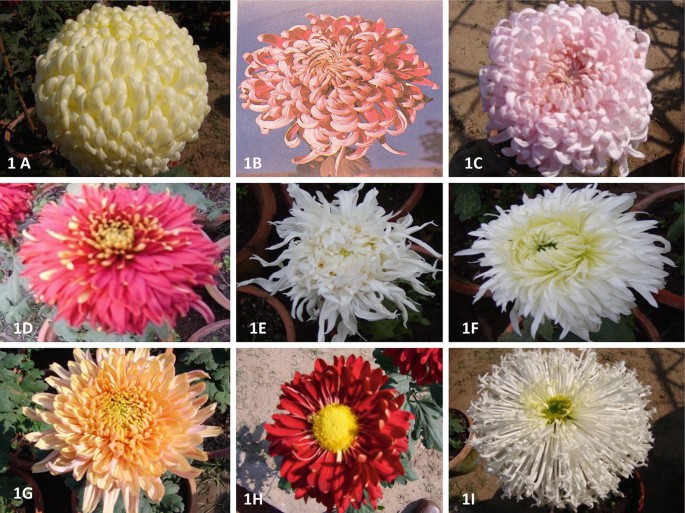
The Reflex Chrysanthemums are quite similar in shape to the blooms of the Incurve “mums”. However, the petals grow outwards and down away from the center disc.
With irregularly shaped petals and stunning colors, these cute little flowers will brighten any garden.
From light and fluffy colors to rich and deep shades, this species offers you many varieties to choose from.
8. Quilled Bloom Chrysanthemum (Chrysanthemum morifolium)
Unique and elegantly spectacular, the Quilled Bloom Chrysanthemum is a delight to the eye. With its very narrow and long petals, it’s one of the more memorable varieties around.
The spiked, quill-like petals grow up to 6 inches in height. This flower has a stunning scent that can attract bees and butterflies and imbue an old garden with life.
Good to know: This flower blooms during the fall and lasts till the first. You can count on it as a late bloomer.
9. Chrysanthemum Brush or Thistle (Chrysanthemum indicum)
The Brush or Thistle Chrysanthemums got their name due to the resemblance of their petals to a paintbrush or thistle flower.
The wispy petals vary in shape and size but can grow up to 2 inches in length. They often change color when the weather gets colder, turning to deeper shades.
Like other species on our list, they grow and bloom during the fall, lasting till the temperature drops. They tend to maintain warm, deep shades throughout their growth period.
Tip: This species is hardier than other varieties and can last longer throughout the year. Cindy and Cisco are popular cultivars.
10. Cushion Chrysanthemums (Chrysanthemum indicum)

Cushion Chrysanthemums are an adorable round-shaped species, resembling tiny cushions! These sweet flowers grow in large, compact bunches.
The most common colors include lilacs, pinks, and whites. Petals vary in shape from tiny spatula petals too long, thin ones.
Good to know: Because it can cope with lower temperatures, this variety can flourish longer into late fall or early winter.
How to Grow Chrysanthemum Flowers and Care for Them
You can count on Chrysanthemum flowers’ hardiness and resistance to cold weather. These are not flowers that will easily shiver once the first cold start blowing!
However, it’s important to give them the right soil, shading, sunlight, and spacing. Otherwise, your plants may be lacking nutrients or competing for them and have a higher risk of developing diseases.
Caring for your flower correctly will lead to a beautiful, healthy bloom, and we’ll show you how to do it.
How to Plant Chrysanthemums
Choose a variety that’s adapted to the weather in your region. That’s the single most important thing to growing these interesting flowers without any hassle.
- If you live in Northern areas with colder weather, it is better to plant this flower during the spring. This will help strengthen the root system and give them a better chance of enduring the winter.
- However, if you live in warmer, southern zones plant your flowers during the end of summer or the beginning of fall. Otherwise, your flowers may die because of the heat.
- Consider the spacing between your plants. If you plant them in spring, your “mums” won’t fill out as much space.
- “Mums” planted directly in the fall will have already bloomed more and therefore need more space. Give them enough space to grow as they can grow over 3 feet in width and the root systems may grow over each other.
Soil
A key factor is to plant the flowers in a patch where the roots have room to spread. The soil must be well-draining, organic soil.
Important: After planting, make sure to keep the soil moist constantly. If not, the soil will be too dry and may cause the roots to break or make it harder for them to become established.
On the other hand, you want to avoid making your soil too wet as you may drown your plant. If you don’t have organic soil, just mix into it some organic compost.
Sunlight

Most plants love sunlight, and “mums” thrive in it. However, since they usually grow in the fall, they tend to prefer cooler weather.
You must have enough shade in your garden to prevent them from totally drying out. Around 6 hours of sunlight per day should be enough for your flowers to thrive.
Your “mums” will start to bud and bloom when they sense a change in temperature and the amount of sunlight they get. In other words, these plants are smart: they can tell when September or October has arrived.
Watering
It’s vital to water your Chrysanthemums regularly during all seasons. This also means keeping the soil moist and avoiding drought.
If the soil is already moist then you don’t need to water the plant. The soil must be wet or moist up to 8 inches deep as this ensures that the water will reach all of the roots.
Tip: Make sure to only water the soil around the flower. Leaving water on the leaves can induce fungal growth.
Pinching or Deadheading
:max_bytes(150000):strip_icc()/spruce-deadheadingflowers-AnnaCinaroglu-d884c77e8f614020a8640ffe74b20546.jpg)
Pinching is another word for pruning, and you want to do it to help your flower reach its full potential. Deadheading is essential if you have planted your “mums” in the spring.
Tip: To get the best blooms, pinch (cut) your flowers back when they grow up to 4-6 inches.
FAQs:
- What are the most popular types of Chrysanthemums?
Some of the most popular types of chrysanthemums include Spider Bloom Chrysanthemum, Pompon Chrysanthemum, Single Bloom Chrysanthemum, Anemone Chrysanthemum, and Incurve Chrysanthemum. Each type offers unique features, such as different petal shapes and sizes, making them suitable for various garden designs. - When is the best time to plant Chrysanthemums?
If you live in colder regions, it’s best to plant chrysanthemums in the spring to help strengthen their root system for the winter. In warmer climates, plant them towards the end of summer or beginning of fall to avoid heat stress. - What do different colors of Chrysanthemums symbolize?
- Yellow Chrysanthemums: Sorrow or neglect
- Red Chrysanthemums: Deep love and passion
- Purple Chrysanthemums: Good health, fast recovery, and support
- White Chrysanthemums: Honesty, loyalty, and devotion
- How should I care for Chrysanthemums to ensure they bloom well?
Ensure that your chrysanthemums have well-draining, organic soil and receive about 6 hours of sunlight per day. Regular watering is important to keep the soil moist, but avoid overwatering, as this can lead to root rot. Deadheading or pinching back the flowers will encourage better blooms. - What is the ideal soil for growing Chrysanthemums?
Chrysanthemums prefer well-draining, organic soil. If your soil lacks organic matter, mix in compost or organic fertilizer to enrich it. Be sure to keep the soil moist, but avoid making it too wet. - Do Chrysanthemums need a lot of sunlight?
While chrysanthemums love sunlight, they also prefer cooler weather. Aim for about 6 hours of sunlight per day for optimal growth. Ensure they are placed in a spot that has enough shade to prevent the soil from drying out completely. - How do I prune Chrysanthemums to encourage better blooms?
Pinching back chrysanthemums when they grow to about 4-6 inches in height helps promote fuller and more abundant blooms. Regular deadheading, or removing spent flowers, will also extend their blooming period. - How do I water Chrysanthemums correctly?
Water chrysanthemums regularly to maintain moist soil, but avoid overwatering. Ensure that the water reaches the root system by watering the soil up to 8 inches deep. Always water the base of the plant and avoid getting water on the leaves to reduce the risk of fungal diseases. - Can I grow Chrysanthemums in containers?
Yes, chrysanthemums can be successfully grown in containers. Choose a container with proper drainage holes, and use a well-draining potting mix. Ensure that the container receives adequate sunlight and water regularly, but be cautious not to overwater. - Are Chrysanthemums winter-hardy?
Chrysanthemums are hardy in most climates, particularly in areas with moderate winters. If you’re in a colder region, you can mulch around the plants to help protect them from frost. In warmer regions, they may bloom year-round with proper care.
By understanding the different types of chrysanthemums, their symbolism, and how to care for them, you can create a thriving and beautiful garden filled with vibrant, colorful blooms. With their ability to brighten up any space, chrysanthemums are truly a standout flower in any garden. Happy gardening!
Conclusion:
Chrysanthemums, or “mums,” are versatile, vibrant flowers that can bring beauty and cheer to any garden. With a variety of types, colors, and meanings, these flowers can be a delightful addition to your outdoor space, whether you’re looking to create a vibrant garden or add a touch of elegance and symbolism. By following the right care instructions—such as ensuring proper planting conditions, regular watering, and adequate sunlight—you can enjoy these resilient flowers year after year. Whether you’re planting them for aesthetic value, cultural significance, or health benefits, chrysanthemums are a wonderful choice for both beginner and experienced gardeners alike.

